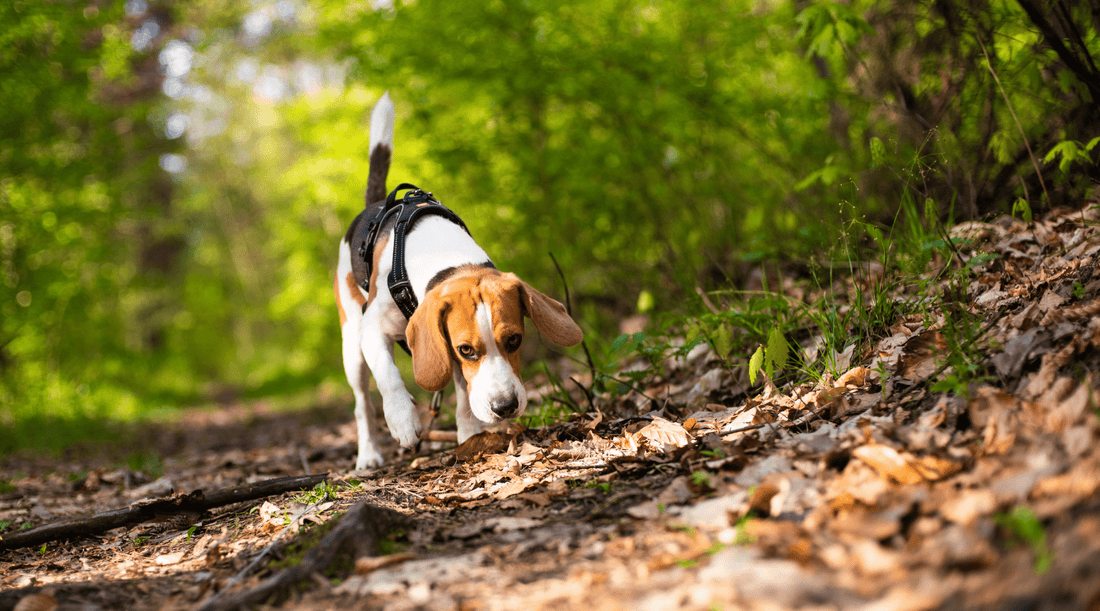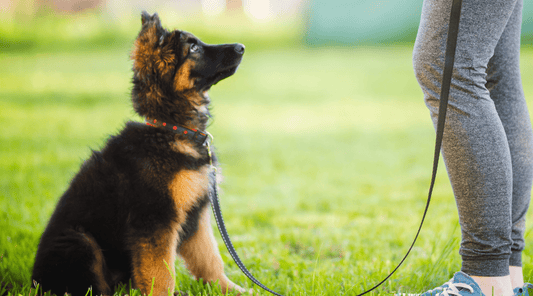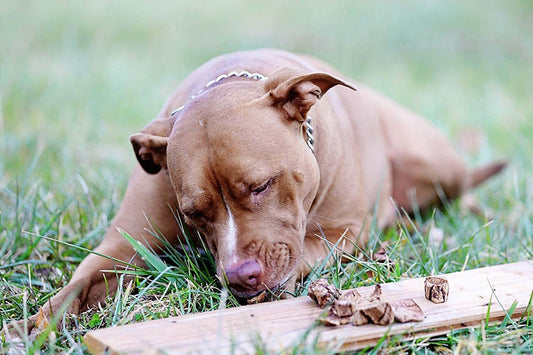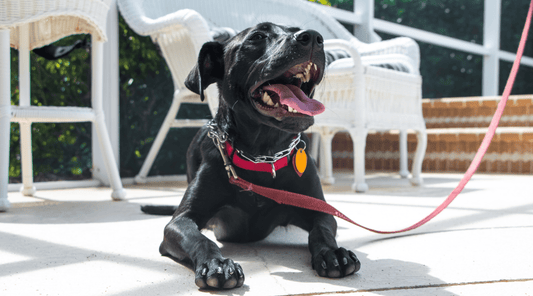
Nose Work Dog Training (Or Why My Backyard Now Smells Like Dog Treats)
Dawn Miller Apr 10, 20254 Minute ReadPixie has a nose that could rival a bloodhound’s. She’s not one, of course—just a scrappy little terrier with a superpower-level sense of smell. And it turns out, her knack for sniffing out treats has led us down a fun training path that I found out a lot of dog parents don't know about: nose work dog training.
It all started during a neighborhood get-together a couple of years ago. Gina, a local dog trainer, had set up a scent-based scavenger hunt for the dogs. Pixie was so focused, I swear she didn't blink the entire time.
“Try hiding a treat in the grass,” Gina suggested, tossing me a piece of beef lung bite from K9 Connoisseur. “See how she responds.”
Watching Pixie's sniffing games in action was like seeing a little detective at work. That night, I went down a rabbit hole researching scent dog training and all its benefits. Here's what I found out.
What Is Nose Work Dog Training?
Have you ever watched your dog’s nose twitch while they investigate something? Then you’ve seen the magic of nose work in action.
This activity essentially taps into their natural sniffing instincts and turns them into a structured activity. Also called "Scent Work", this activity becomes a game they get to play with you.
When my college-age kids were small, we loved the annual egg hunt at the neighborhood park. Nose work training is a lot like that, except you aren't spending hours boiling and dying eggs.
It's so easy to nose train a dog.
Pixie? She just loves the hunt. And, let’s be real, the reward that comes after.
Benefits of Nose Work Dog Training
Playing structured games with your dog:
- Strengthens your bond
- Reinforcing dog manners
- Gives both of you a little extra exercise
- Is mental stimulation for dogs
- Builds confidence
- Channels their natural instinct to sniff things out
Dogs who are hyper, nervous, or reactive benefit the most from games like this. Better than therapy.
And they don't just benefit while playing. They experience a calmer, more confident mental state long after the game is over.
It allows them to run off nervous energy and enhances their focus.
How to Start Nose Training
I decided to give nose work training a real go with Pixie. Here's how I did it.
1. Choose High-Value Training Treats
The first step? Find something your dog is really excited about. For Pixie, she has to get K9 Connoisseur’s beef lung bites, or it's a no-go.
The moment she catches a whiff, it’s game on.
Now, people do ask me this. So, I want to be clear. I can't smell these roasted organ meat treats. But dog noses—that's a different story.
2. Begin with Simple Hiding Spots
Start indoors where distractions are minimal. Hide the treat under a towel, in a corner, or behind a chair. Make it easy at first—dogs learn fastest when they experience success early on.
I either hide treats while my dogs take their morning nap in another room. Or I use the "go to crate" command during the hiding process.
I found this was a lot easier than getting my dogs to keep their eyes closed and count to 50.
Of course, you can also play the quick version any time by tossing their treats into bushes or sprinkling them in the grass.
3. Use a Cue Word
I use “Find it!” as Pixie’s cue to start sniffing. When she catches the scent and finds the treat, she gets praise and the treat for her effort.
4. Gradually Increase Difficulty
Once Pixie mastered the basics, I started hiding treats outside. Beneath leaves, in the grass, on the low limb of a sapling, even under an empty flowerpot that I wasn't too worried about her tipping over.
Sniffing Games for Dogs: Variant Keep it Interesting
Nose Training Games for Beginners
Got a rookie? Start with these versions.
Find the Treats
Hide treats around the house or yard and encourage your dog to sniff them out.
Shell Game
Place a treat under one of three cups and shuffle them around. Let your dog choose the correct cup.
Advanced Scent Work Games
Once they've mastered some of the easier variations, build their confidence by increasing the game's difficulty.
Scent Trails
Drag a treat along the ground and hide it at the end of the trail. This one’s Pixie’s absolute favorite. She reminds me of Trusty, the bloodhound from Lady and the Tramp, nose close to the ground, following the scent.
Tracker Training
Dogs can learn to follow any kind of scent. So, if you fancy your K9 a dog detective, why not have them track scents like lavender or vanilla? Hide the scented item in the yard. Place the scent on a cloth or something similar that you can hold in your hand.
Introduce them to the scent. Then say, "Find it." When they do, praise them and give them real dog treats—not vanilla-flavored ones.
You can teach them faster with a clicker. Then give them a dog treat.
I share how clicker training speeds up dog training over here.
Once they learn "find it" at this level, you could theoretically enroll them in K9 cop training...or just use this trick next time you can't find your keys.
Why Nose Work Is Perfect for Mental Stimulation for Dogs
Just like a child climbing the walls in the pediatrician's waiting room before smartphones existed, dogs get antsy and nervous when they don't have mental stimulation. Playing games is a great way to redirect this energy positively.
I used to think Pixie needed endless running and chasing to stay happy and manageable. I tried taking her on more (and longer) walks, but nothing ran off all that nervous energy.
But exercising her brain finally did the trick, too. Nose training is just one way to increase her mental stimulation and reduce her hyperactivity and nervousness. She's become a more even-keeled dog.
Here are some other ways I give her the mental stimulation she needs to feel well.
Regular Dog Training Sessions
Pixie has so many skills. But she didn't come pre-programmed. We've been training together for the past few years, for 5-10 minutes every day.
Situational Dog Training
I also take every opportunity to reinforce her training in the real world.
For example,
- I say "sit" before I open the door for us to go outside
- I say "stay", wait a few seconds, and then "load up" before we load up into a vehicle.
- I say "leave it" while I'm pouring her kibble, and then "okay" when I'm done. She waits patiently.
I've basically taught all my dogs house manners that allow us to cooperate in daily life.
Dog Bone Chew Sessions
For dogs, chewing on dog bones is instinct. It relieves anxiety, stops destructive chewing, and promotes well-being. My dogs love their dog bone chew sessions, 2-3 dog bones every week, and I reap the rewards with better-behaved dogs.
And if you’re looking for more dog training tips? Try the 7-Day Dog Training Challenge. We designed this event to challenge both you and your dog to learn essential dog commands and strengthen your bond with each other.
👉 Join here
Available On:


Disclosure: This article may contain affiliate links, which means we may earn a small commission if you make a purchase through these links—at no extra cost to you. We only recommend products we trust and believe will benefit you and your K9.



